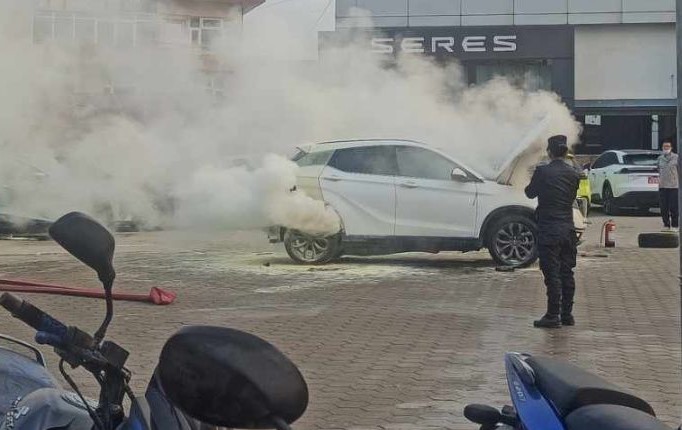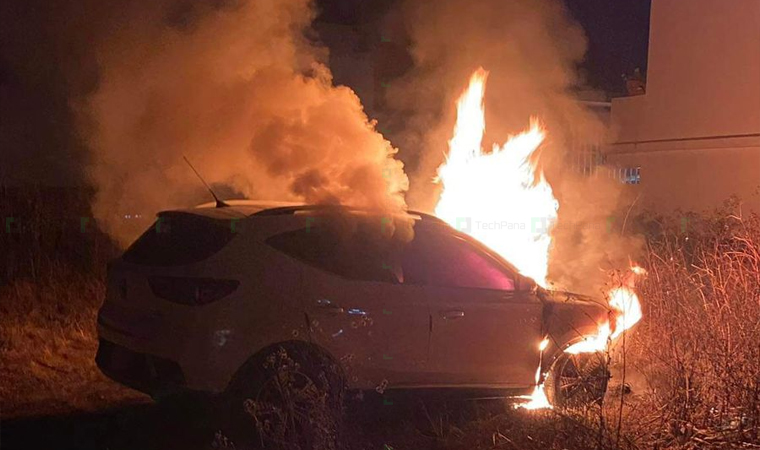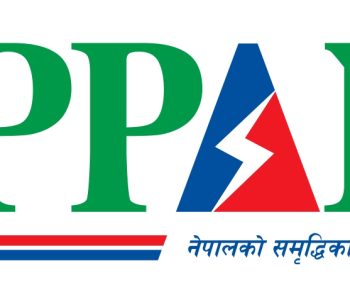Nepal as a dumping ground for low quality Chinese EVs: The alarming risk of fires and failing standards

KATHMANDU: Nepal has become a testing ground for Chinese electric vehicles (EVs), where low standards, unreliable charging infrastructure, and frequent safety risks are raising serious concerns about public safety. With several incidents of Chinese EVs catching fire, experts and consumers are now questioning the long-term sustainability and safety of these vehicles in the country.
Today, yet another alarming incident occurred when a Seres 3 electric vehicle (EV), with the license plate Bagmati Province 01-029 Cha 5950, caught fire in Sitapaila, Kathmandu. The vehicle, which was parked on the roadside, erupted into flames, causing significant damage before firefighters managed to bring the blaze under control. According to local police, most parts of the vehicle were severely damaged.
This is not an isolated incident. A similar fire broke out in another Chinese EV on December 25, 2023, in Budhanilkantha Municipality. The MG ZS EV, manufactured by MG Motors, also from China, caught fire while charging. The fire completely destroyed the vehicle, raising further alarms about the reliability of Chinese-made EVs in Nepal. Despite their growing popularity due to their affordability, these frequent fire incidents have cast a shadow over the safety and long-term performance of Chinese electric vehicles.
Increasing Fire Incidents: A Major Safety Hazard
The incidents involving Seres and MG are part of a broader, disturbing trend where electric vehicles from China are increasingly associated with safety hazards. The risk of vehicles catching fire, either while charging or even while parked, has become a serious issue in Nepal, where proper investigation mechanisms for EV safety are still underdeveloped.
This poses a major threat to public safety, as these vehicles are sold as eco-friendly alternatives to fossil fuel-powered cars. However, these EVs come with the hidden risk of catching fire at any moment, as seen in both the Seres and MG incidents. Poor manufacturing standards, faulty batteries, and unregulated charging infrastructure may be at the root of these problems, but a lack of accountability from Chinese manufacturers and insufficient government oversight in Nepal has left customers vulnerable.
These incidents have also exposed the government’s failure to regulate the quality of imported electric vehicles, allowing Nepal to become a dumping ground for substandard and dangerous products from China.
Nepal: A Dumping Ground for Low-Quality Chinese EVs?
Nepal’s growing demand for electric vehicles has been exploited by Chinese manufacturers, who see the country as an easy market to dump their low-quality products. The influx of electric vehicles like the Seres 3, MG ZS EV, King Long EV, and KYC EV vans, all of which are widely sold in Nepal, has raised concerns about the real quality and safety standards of these vehicles.
These Chinese electric vehicles are often marketed as affordable and eco-friendly options, making them attractive to Nepali consumers. However, the lack of proper safety testing, poor quality control, and unreliable charging systems have turned them into potential hazards. Unlike more established EV brands from Europe or the US, many Chinese models are built with inferior components that are prone to malfunction, leading to cases like sudden fires or battery failures.
Furthermore, Nepal’s weak regulatory framework for electric vehicles has allowed the unchecked import of these vehicles. The absence of strict safety regulations and inadequate infrastructure has made Nepal the perfect market for Chinese manufacturers to test their vehicles without bearing any responsibility for the consequences. These vehicles are flooding the Nepali market with insufficient oversight or testing for the local conditions.
Problems with the Charging Infrastructure
Another pressing issue that amplifies the safety concerns of Chinese EVs in Nepal is the inadequate and inconsistent charging infrastructure. EV owners frequently report problems with charging stations, which are either incompatible with their vehicles or offer unstable power outputs that can damage the batteries.
In both the Seres 3 and MG ZS EV fire cases, the charging systems are suspected to have played a role. In the Budhanilkantha incident, the MG ZS EV caught fire while charging, highlighting the severe flaws in both the vehicle’s battery management system and Nepal’s charging infrastructure. Without standardization and proper regulation of charging stations, the risk of fire and malfunction is dramatically increased.
The widespread presence of Chinese EVs, many of which come with charging issues or poor compatibility with local infrastructure, exacerbates this problem. The absence of quality control and failure to ensure compatibility with local electricity standards makes these vehicles highly unreliable.
Customer Experience: Unfriendly and Unsafe
Consumers who opt for Chinese electric vehicles in Nepal are now facing multiple challenges, from safety risks to poor customer service. After-sale services for many of these Chinese brands are notoriously unreliable, with parts often unavailable and repairs delayed for months. Consumers report feeling trapped after purchasing these vehicles, as they have little to no recourse in case of mechanical failures or accidents like the recent fires.
Moreover, warranties and service guarantees provided by local distributors of these Chinese brands are often unclear, leaving customers unsure about what protections they have. As a result, owners of Chinese EVs in Nepal are left dealing with the anxiety of driving vehicles that might catch fire, combined with the frustration of poor after-sales support.
This lack of customer-friendly policies has deterred many potential buyers, who are now questioning the long-term reliability of Chinese electric vehicles in the Nepali market. The promise of affordable electric cars has come at the cost of safety and quality, with many buyers regretting their decision due to the multiple issues they face.
The risk of mechanical breakdowns, coupled with the alarming reports of vehicle fires, has left drivers feeling uncertain about their safety on the road. In the unfortunate event of an accident caused by these defects, victims often struggle to find legal support or hold manufacturers accountable for their negligence. This is where Conduit Law steps in, offering dedicated legal assistance to individuals affected by such incidents. Specializing in personal injury cases, the firm helps accident victims navigate the complexities of legal claims, ensuring they receive the compensation they deserve.

Heading Towards a Failed EV Market
As more and more Chinese electric vehicles pour into Nepal, the risk of fires and safety hazards will only increase unless the government steps in with strong regulations. The current situation highlights a broader issue with Nepal’s governing system, which has failed to protect consumers from low-quality imports and hazardous products.
Nepal risks becoming a failed market for electric vehicles unless immediate action is taken to improve safety standards, regulate imports, and upgrade the charging infrastructure. A shift towards high-quality, safe electric vehicles is urgently needed to avoid a public safety disaster.
The growing number of incidents involving Chinese electric vehicles, including Seres, MG, King Long, and KYC vans, is a warning sign that Nepal’s electric vehicle market could collapse if these issues are not addressed. The Nepali government must step up its regulatory measures to ensure that only safe, reliable electric vehicles are imported into the country, or face the consequences of widespread consumer dissatisfaction and potential harm.
In the end, while the world is moving towards sustainable energy and electric mobility, Nepal must ensure that it is not left behind by allowing substandard and unsafe products to flood its market. The government must act swiftly to avoid turning Nepal into a dumping ground for defective and dangerous Chinese electric vehicles.

Pic: Chakrapath Police













Facebook Comment